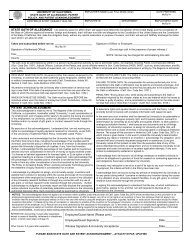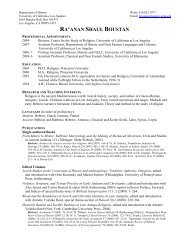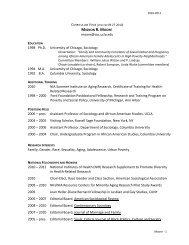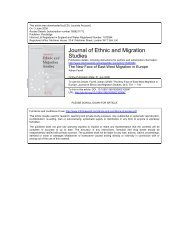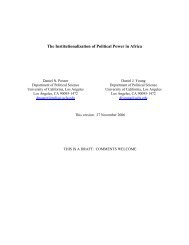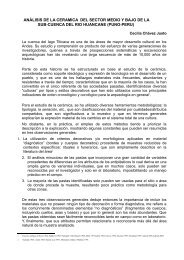The Long-Term Effects of Africa's Slave Trades - Social Sciences ...
The Long-Term Effects of Africa's Slave Trades - Social Sciences ...
The Long-Term Effects of Africa's Slave Trades - Social Sciences ...
Create successful ePaper yourself
Turn your PDF publications into a flip-book with our unique Google optimized e-Paper software.
5.2.2 Initial Population Density<br />
<strong>The</strong> second IV strategy is to use initial population density as an instrument.<br />
As shown in Section 5.1, slaves tended to be exported from areas with high<br />
initial population densities. This suggests that population density is a possible<br />
instrument for slave exports. However, it is unlikely that initial population<br />
density satisfies the necessary exclusion restrictions. <strong>The</strong>re are two<br />
reasons for this. First, past population density will be positively correlated<br />
with good initial characteristics <strong>of</strong> the country, which may persist, affecting<br />
current income. However, this correlation, as I show in Section B <strong>of</strong><br />
the appendix, results in an IV estimate that is biased towards zero. <strong>The</strong>refore,<br />
the IV estimate can be taken as a lower bound estimate. Second, past<br />
population density is correlated with current population density, which may<br />
affect income directly. Herbst (2000) argues that low population densities<br />
are responsible for Africa’s poor economic performance. Again, if this relationship<br />
exists, then the IV estimate will be biased towards zero, and can<br />
be taken as a lower bound estimate. I also control for current population<br />
density in the second stage.<br />
<strong>The</strong> IV results are reported in Table 6. In all specifications, the estimated<br />
coefficient for the log <strong>of</strong> population density in 1400 is positive, as<br />
expected, and statistically significant. <strong>The</strong> IV estimates for ln(exports/area)<br />
are negative and larger in magnitude than the OLS estimates. In general,<br />
these IV estimates are lower than the IV estimates when the distance to<br />
slave markets (reported in Table 5) are used. This is consistent with the<br />
population density IV estimates being biased towards zero and therefore<br />
being lower bound estimates.<br />
5.3 Controlling for Additional Country Characteristics<br />
<strong>The</strong> third strategy is to control for additional country characteristics that<br />
may affect income per capita, and therefore bias OLS estimates, if omitted<br />
from the regression equations. <strong>The</strong> results are reported in Table 7. In the<br />
first column, I add to the estimating equation five region fixed effects: Central<br />
Africa, Western Africa, Southern Africa, Eastern Africa, and Northern<br />
Africa. <strong>The</strong> fixed effects control for any country characteristics that differ<br />
by region.<br />
I also include variables that control for differences in countries’ physical<br />
environment, endowments <strong>of</strong> natural resources, culture, and religion.<br />
In columns 2 to 4, I control for a country’s geographic environment, by<br />
including distance to the equator, natural openness measured by the log<br />
33




